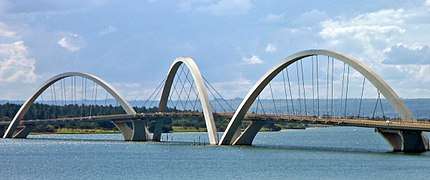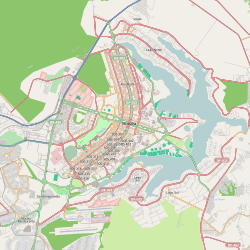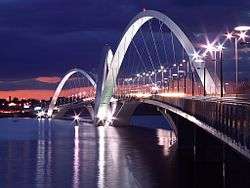Juscelino Kubitschek bridge
| Juscelino Kubitschek Bridge | |
|---|---|
 Juscelino Kubitschek Bridge viewed from the eastern shore of Lake Paranoá. | |
| Coordinates | 15°49′25″S 47°49′46″W / 15.82361°S 47.82944°WCoordinates: 15°49′25″S 47°49′46″W / 15.82361°S 47.82944°W |
| Carries | vehicular, bicycle, pedestrian traffic |
| Crosses | Lake Paranoá |
| Locale | Brasilia, DF, Brazil[1] |
| Official name | Ponte Presidente Juscelino Kubitschek |
| Maintained by | Governo do Distrito Federal |
| Characteristics | |
| Design | asymmetric arch bridge with suspended deck[1] |
| Total length | 1,200 metres (3,900 ft)[1] |
| Width | 24 metres (79 ft)[1] |
| Height | 60 metres (200 ft)[1] |
| Longest span | 240 metres (790 ft)[1] |
| Clearance above | 18 metres (59 ft) |
| Clearance below | 18 metres (59 ft) |
| History | |
| Designer | Alexandre Chan and Mário Vila Verde[1] |
| Construction start | 2000 |
| Construction end | 2002 |
| Opened | 2002 |
 | |

Juscelino Kubitschek Bridge (Portuguese: Ponte Juscelino Kubitschek), commonly called Ponte JK (English: JK Bridge), is a steel and concrete arch bridge across Lake Paranoá in Brasília, Brazil. It connects the eastern shore of the lake – where Lago Sul, Paranoá and Brasília International Airport are located – to Brasília's city center, via the Monumental Axis. Opened to traffic on December 15, 2002, its distinctive silhouette quickly became a Brasília landmark.[2]
The bridge is named after President Juscelino Kubitschek, who served from 1956 to 1961, and is generally considered the main figure supporting the construction of the planned city of Brasília. It was designed by architect Alexandre Chan and structural engineer Mário Vila Verde.[3]
Description
The bridge structure is 1,200 metres (3,900 ft) long, 24 metres (79 ft) wide and has two three-lane carriageways in each direction and walkways fitted with guard-rails on either for cyclists and pedestrians, each 1.5 metres (4.9 ft) wide, and three 240 metres (790 ft) spans. The main span structure has four supporting pillars standing on the Lake Paranoá lakebed; and the deck weight is supported by three 200-foot-tall (61 m) asymmetrical steel arches that crisscross diagonally. The decks are suspended by steel cables alternating at each side of the deck, interlacing in a twisted plane. The entire structure has a total length of 1,200 metres (3,900 ft), and was completed at a cost of US$56.8 million.[4] The bridge has a pedestrian walkway and is accessible to pedestrians and bicyclists.
Awards
Alexandre Chan received the Gustav Lindenthal Medal for the bridge's project at the 2003 International Bridge Conference in Pittsburgh. This medal is awarded "for a single, recent outstanding achievement showing harmony with the environment, aesthetic merit and successful community participation".[5]
The bridge was also awarded the 2003 Premio Abcem (ABCEM Award) for "Best Steel Work of the Year, Bridges and Highway Overpasses Category", granted by the Brazilian Metal Construction Association (Associação Brasileira da Construção Metálica, ABCEM).[6]
Gallery
 JK Bridge at night
JK Bridge at night- Aerial view of the bridge

 Approach to the bridge from its eastern shore
Approach to the bridge from its eastern shore
References
- 1 2 3 4 5 6 7 Juscelino Kubitschek Bridge at Structurae
- ↑ Ministério dos Transportes. "Ficha Ponte Juscelino Kubitschek - Histórico" (in Portuguese). Archived from the original on 2008-03-13. Retrieved 2008-03-08.
- ↑ A Tercira Ponte no Lago Sul (in Portuguese)
- ↑ Correio Braziliense (2003-01-07). "O novo point" (in Portuguese). Retrieved 2008-03-08.
- ↑ Gustav Lindenthal Medal Winners Archived 2012-07-17 at the Wayback Machine. (International Bridge Conference Award Winners)
- ↑ ABCEM 2003 Awards: Ponte Juscelino Kubistchek (in Portuguese)
External links
- (in Portuguese) Photo 360° of JK Bridge - GUIABSB
- International Bridge Conference Award Winners
- (in Portuguese) Associação Brasileira da Construção Metálica
- Satellite picture on Google Maps
- Night photo showing pedestrian / bike path
- Daytime photo
- (in Portuguese) Interview with architect Alexandre Chan
| Wikimedia Commons has media related to Juscelino Kubitschek Bridge. |